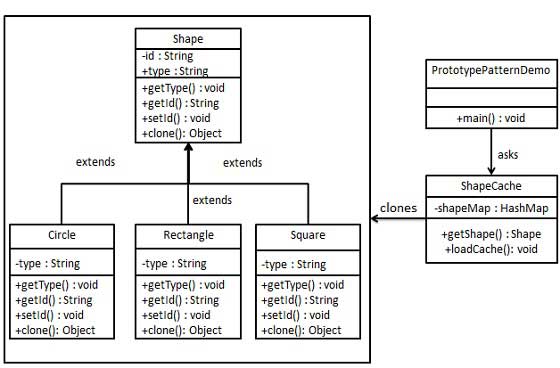设计模式:原型模式
原型模式
概念
原型模式(Prototype Pattern)是用于创建重复的对象,同时又能保证性能。这种类型的设计模式属于创建型模式,它提供了一种创建对象的最佳方式。
这种模式是实现了一个原型接口,该接口用于创建当前对象的克隆。当直接创建对象的代价比较大时,则采用这种模式。例如,一个对象需要在一个高代价的数据库操作之后被创建。我们可以缓存该对象,在下一个请求时返回它的克隆,在需要的时候更新数据库,以此来减少数据库调用。
实现
我们将创建一个抽象类 Shape 和扩展了 Shape 类的实体类。下一步是定义类 ShapeCache,该类把 shape 对象存储在一个 Hashtable 中,并在请求的时候返回它们的克隆。
PrototypPatternDemo,我们的演示类使用 ShapeCache 类来获取 Shape 对象。

步骤 1
创建一个实现了 Clonable 接口的抽象类。
Shape.java
1 | public abstract class Shape implements Cloneable { |
步骤 2
创建扩展了上面抽象类的实体类。
Rectangle.java1
2
3
4
5
6
7
8
9
10
11public class Rectangle extends Shape {
public Rectangle(){
type = "Rectangle";
}
public void draw() {
System.out.println("Inside Rectangle::draw() method.");
}
}
Square.java1
2
3
4
5
6
7
8
9
10
11public class Square extends Shape {
public Square(){
type = "Square";
}
public void draw() {
System.out.println("Inside Square::draw() method.");
}
}
Circle.java1
2
3
4
5
6
7
8
9
10
11public class Circle extends Shape {
public Circle(){
type = "Circle";
}
public void draw() {
System.out.println("Inside Circle::draw() method.");
}
}
步骤 3
创建一个类,从数据库获取实体类,并把它们存储在一个 Hashtable 中。
ShapeCache.java1
2
3
4
5
6
7
8
9
10
11
12
13
14
15
16
17
18
19
20
21
22
23
24
25
26
27
28
29import java.util.Hashtable;
public class ShapeCache {
private static Hashtable<String, Shape> shapeMap
= new Hashtable<String, Shape>();
public static Shape getShape(String shapeId) {
Shape cachedShape = shapeMap.get(shapeId);
return (Shape) cachedShape.clone();
}
// 对每种形状都运行数据库查询,并创建该形状
// shapeMap.put(shapeKey, shape);
// 例如,我们要添加三种形状
public static void loadCache() {
Circle circle = new Circle();
circle.setId("1");
shapeMap.put(circle.getId(),circle);
Square square = new Square();
square.setId("2");
shapeMap.put(square.getId(),square);
Rectangle rectangle = new Rectangle();
rectangle.setId("3");
shapeMap.put(rectangle.getId(),rectangle);
}
}
步骤 4
PrototypePatternDemo 使用 ShapeCache 类来获取存储在 Hashtable 中的形状的克隆。
PrototypePatternDemo.java1
2
3
4
5
6
7
8
9
10
11
12
13
14public class PrototypePatternDemo {
public static void main(String[] args) {
ShapeCache.loadCache();
Shape clonedShape = (Shape) ShapeCache.getShape("1");
System.out.println("Shape : " + clonedShape.getType());
Shape clonedShape2 = (Shape) ShapeCache.getShape("2");
System.out.println("Shape : " + clonedShape2.getType());
Shape clonedShape3 = (Shape) ShapeCache.getShape("3");
System.out.println("Shape : " + clonedShape3.getType());
}
}
步骤 5
验证输出。1
2
3Shape : Circle
Shape : Square
Shape : Rectangle
适用环境
- 如果创建新对象成本较大,我们可以利用已有的对象进行复制来获得。
- 如果系统要保存对象的状态,而对象的状态变化很小,或者对象本身占内存不大的时候,也可以使用原型模式配合备忘录模式来应用。相反,如果对象的状态变化很大,或者对象占用的内存很大,那么采用状态模式会比原型模式更好。
- 需要避免使用分层次的工厂类来创建分层次的对象,并且类的实例对象只有一个或很少的几个组合状态,通过复制原型对象得到新实例可能比使用构造函数创建一个新实例更加方便。
模式总结
原型模式向客户隐藏了创建对象的复杂性。客户只需要知道要创建对象的类型,然后通过请求就可以获得和该对象一模一样的新对象,无须知道具体的创建过程。
克隆分为浅克隆和深克隆两种。
我们虽然可以利用原型模式来获得一个新对象,但有时对象的复制可能会相当的复杂,比如深克隆。
参考资料: